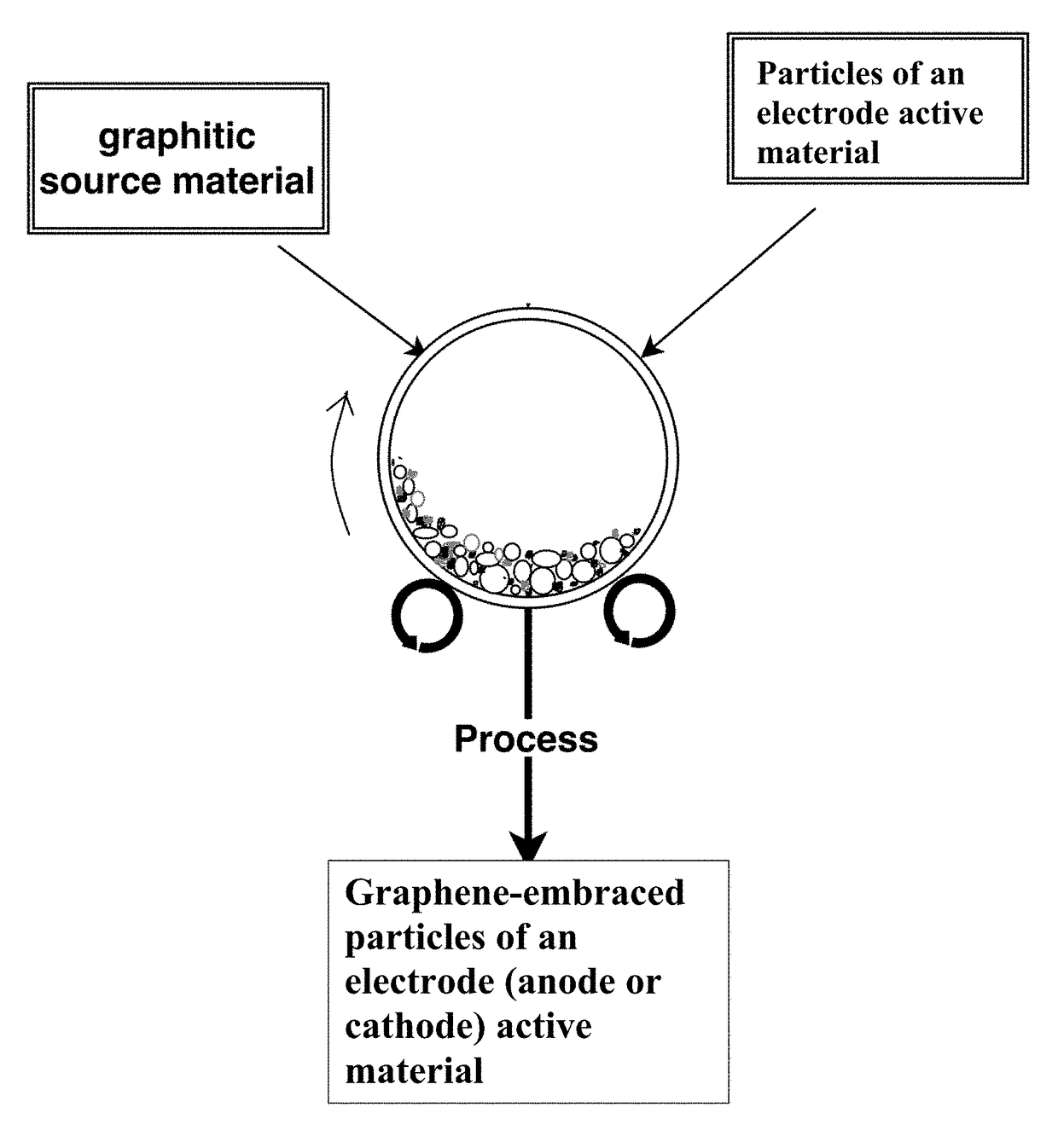Chemical-free production of graphene-encapsulated electrode active material particles for battery applications
a graphene-encapsulated electrode and active material technology, applied in the field of lithium batteries, can solve the problems of high energy consumption, inability to mass produce ngps, and inability to meet the mass production of ngps, so as to improve the mechanical properties, electrical conductivity and thermal conductivity of an electrode, and enhance the capacity for lithium capture and storage.
- Summary
- Abstract
- Description
- Claims
- Application Information
AI Technical Summary
Benefits of technology
Problems solved by technology
Method used
Image
Examples
example 1
Embraced Particles of Electrode Active Materials
[0141]Several types of electrode active materials (both anode and cathode active materials) in a fine powder form were investigated. These include Co3O4, Si, LiCoO2, LiMn2O4, lithium iron phosphate, etc., which are used as examples to illustrate the best mode of practice. These active materials either were prepared in house or were commercially available.
[0142]In a typical experiment, 1 kg of electrode active material powder and 100 grams of natural flake graphite, 50 mesh (average particle size 0.18 mm; Asbury Carbons, Asbury N.J.) were placed in a high-energy ball mill container. The ball mill was operated at 300 rpm for 0.5 to 4 hours. The container lid was then removed and particles of the active materials were found to be fully coated (embraced or encapsulated) with a dark layer, which was verified to be graphene by Raman spectroscopy. The mass of processed material was placed over a 50 mesh sieve and, in some cases, a small amoun...
example 2
lized Graphene-Encapsulated Sn Particles
[0143]The process of example 1 was replicated with the inclusion of 50 grams of urea as a nitrogen source. The coated powder created was functionalized graphene-encapsulated Sn particles for use as an anode active material in a lithium-ion battery. It may be noted that chemical functionalization is used to improve wettability of the electrode active material by the electrolyte or the compatibility between the electrode active material and the electrolyte in a battery.
Example 3: Graphene-Embraced SnO2 Particles
[0144]In an experiment, 2 grams of 99.9% purity tin oxide powder (90 nm diameter) and 0.25 grams highly oriented pyrolytic graphite (HOPG) were placed in a resonant acoustic mill and processed for 5 minutes. For comparison, the same experiment was conducted, but the milling container further contains zirconia milling beads. We were surprised to discover that the former process (tin oxide particles serving as the milling media per se witho...
example 4
Encapsulated Si Micron Particles
[0145]In a first experiment, 500 g of Si powder (particle diameter˜3 μm) and 50 grams of highly oriented pyrolytic graphite (HOPG) were placed in a high-intensity ball mill. The mill was operated for 20 minutes, after which the container lid was opened and un-processed HOPG was removed by a 50 mesh sieve. The Si powder was coated with a dark layer, which was verified to be graphene by Raman spectroscopy.
[0146]In a second experiment, micron-scaled Si particles from the same batch were pre-coated with a layer of polyethylene (PE) using a micro-encapsulation method that includes preparing solution of PE dissolved in toluene, dispersing Si particles in this solution to form a slurry, and spry-drying the slurry to form PE-encapsulated Si particles. Then, 500 g of PE-encapsulated Si particles and 50 grams of HOPG were placed in a high-intensity ball mill. The mill was operated for 20 minutes, after which the container lid was opened and un-processed HOPG wa...
PUM
| Property | Measurement | Unit |
|---|---|---|
| thickness | aaaaa | aaaaa |
| thickness | aaaaa | aaaaa |
| thickness | aaaaa | aaaaa |
Abstract
Description
Claims
Application Information
 Login to View More
Login to View More - R&D
- Intellectual Property
- Life Sciences
- Materials
- Tech Scout
- Unparalleled Data Quality
- Higher Quality Content
- 60% Fewer Hallucinations
Browse by: Latest US Patents, China's latest patents, Technical Efficacy Thesaurus, Application Domain, Technology Topic, Popular Technical Reports.
© 2025 PatSnap. All rights reserved.Legal|Privacy policy|Modern Slavery Act Transparency Statement|Sitemap|About US| Contact US: help@patsnap.com



